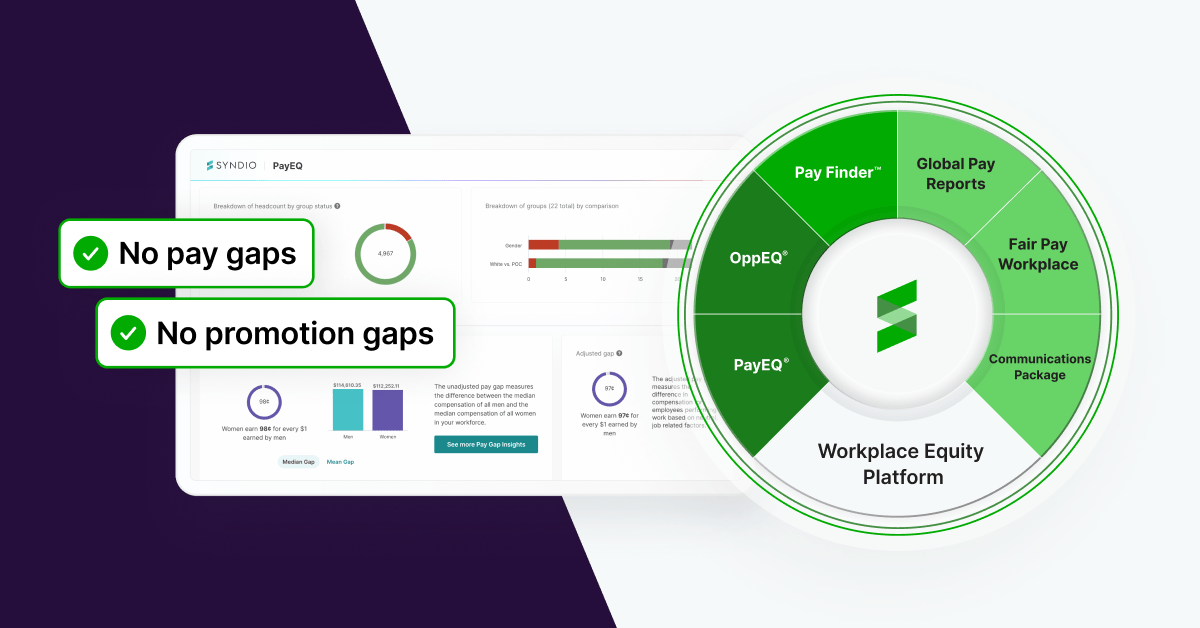Is pay compression upending your compensation strategy? Recent research from Syndio shows that in 83% of high-paying job groups, defined as those with an average salary of $125,000 or more, tenured employees tend to not make more than new employees. In fact, 30% of the time, they actually make less. And as salary ranges go public, employees are increasingly aware of how their salary compares to their colleagues’, creating a “perfect storm” of pressures on employers’ pay practices.
In today’s competitive labor market, it is essential for businesses to ensure that employees are fairly compensated and that pay structures reward what the organization intends, such as skills, responsibilities, and experience. Employers must take steps to understand how pay compression can affect pay/workplace equity and develop strategies for avoiding its negative effects.
Below, we discuss the concept of pay compression from different angles and explore methods of analyzing its consequences on companies’ pay practices and pay equity.
What is pay compression and what causes it?
Pay compression is most often seen in the following two employment scenarios:
- Between job levels: This type of pay compression occurs as the differential between job levels is squeezed. It may have the effect of the higher-level position appearing less-valued, since the lower-level position, requiring less experience and/or skills, is paid more closely to the higher-level position. For example, a retail company has trouble hiring entry-level salespeople, so it raises its hourly wages, leading to hourly workers making similar amounts to the senior sales associates or shift supervisors above them. It can also happen when an organization is short-staffed at lower-levels so that hourly workers are paid a lot of overtime.
- Between new hires and tenured employees: This type of pay compression occurs when new hires are offered high salaries and bonuses similar to or more than what tenured employees in similar roles are making. For example, due to a competitive job market, a tech company offers salaries on the high end of salary bands to new hires but doesn’t increase salaries correspondingly for current employees, leading to people who are more recent to a job being paid more than the employees who’ve been in the job for a long time.
What causes pay compression?
There are two main factors at work causing compression:
- A competitive job market, leading to higher salaries and bonuses offered to attract top talent, which in turn is leading to new hires being paid the same or more than long standing employees in similar roles.
- Annual merit budgets that have been relatively small (~3% for many years) and used to both reward employees for individual performance and keep up with the market. Merit increases have traditionally been allocated using a combination of performance and position in the salary range (and/or “compa ratio”, calculating distance from the midpoint). While salary ranges are reviewed periodically to ensure they are, overall, keeping up with the market, they are not designed to keep up with the rapid rise in wages we have witnessed recently. Therefore, the guidance being used to ensure employees are paid competitively falls behind.
“That’s not fair.”
Pay compression undermines your pay philosophy by eroding the connection between pay and what you want to reward, such as skills, job responsibilities, and experience. When pay no longer reflects and incentivizes the factors you want to reward, employees may feel demotivated or disengaged (the opposite of what you intend!). After all, why should employees bother to stay and gain new skills or take on greater responsibilities if they won’t be rewarded for it? Why not job-hop to make more money?
“Remember, with pay, perception is reality: how employees feel about their compensation impacts their satisfaction with their employer and their desire to stay.” –
– Chris Martin, Syndio research economist | Greener Pastures: Why Do New Hires Get Paid More?
Overall, pay compression creates a feeling of unfairness to the detriment of your employee experience. As global HR analyst Josh Bersin said during a webinar with Syndio, “It isn’t the level of pay that creates employee engagement — it’s the fairness of pay.” People want to feel they are valued fairly compared to their colleagues. If they don’t, you’ll experience complaints, turnover, and reduced productivity.
Two pay compression dimensions to consider: pay equity and opportunity equity
How pay compression can impact pay equity
Pay equity is compensating people performing equal, substantially similar, or comparable work in a way that is not based on workers’ gender or other protected category characteristic (like race or ethnicity), but instead may be explained by neutral, job-related factors that differentiate workers’ experience, skills, effort, accountability and working conditions.
Pay compression between new hires and tenured employees weakens the valuation and reward of one of the key components often cited as explaining differences in pay: experience. If experience is a factor in your pay philosophy for distinguishing pay, and you are measuring it in part by using tenure, then pay compression between new hires and tenured employees becomes problematic. It reveals inconsistencies between how you say you pay and how you are paying people in practice, and it is often a practice that is not being consistently applied across the organization (that is, some jobs may be impacted differently than other jobs). This weakens your ability to both explain pay differences with objective factors as well as ensure that pay decisions are being made consistently across your organization so you can preserve pay equity.
How pay compression can impact opportunity equity
Opportunity equity means that all employees have equitable access to opportunities for employment, advancement, and development — regardless of gender, race, or other factors. Pay compression between job levels is problematic because it calls into question how you reward increasing responsibilities. It reveals the inconsistency between how you say you reward people for increasing responsibilities and how it is done in practice, and, again, we know that these practices are often not consistent across the organization. If some employees are rewarded for advancement and others are not rewarded in the same way, employees are left to wonder if they can trust that they are being afforded the opportunities for advancement you are promising.
Employees’ understanding and perception of your pay practices — that they are transparent and consistent — is fundamental to retaining and engaging them.
How to analyze the impact of pay compression on workplace equity
Syndio’s PayEQ® , Pay Policy Analytics, and Pay Finder™ solutions have powerful analytics capabilities that can be used to compare a wide range of compensation practices beyond those related to pay equity.
For example, using PayEQ, you can conduct an analysis by:
- Creating comparison groups of recently-hired employees vs. longer-tenured employees
- Applying controls as you normally would in your analysis, with the exception of how you have been quantifying experience
- Observing if there is a difference between the two groups
This will help you see if there are any significant differences in pay by job, in specific departments, or in specific locations, so you more fully understand the scale of issues with compression and can more specifically address them.
Syndio’s Pay Policy Analytics can be used to examine more in-depth the extent to which employees’ tenure influences pay. Pay Policy Analytics provides you detailed information about how each control you apply is driving pay, and you can dig into not only the scale with which it drives pay job group by job group, but also the extent to which it impacts one comparison group over another. Again, this provides you with a path to addressing compression in a more surgical manner in your organization.
Syndio’s Pay Finder provides you immediate insights at the job level that can help you provide the right just-in-time guidance to preserve internal pay equity and combat compression creeping in. By job, you can see:
- Your market data or salary range
- Your internal equitable pay range based on your pay equity analysis
- The array of current employees’ salaries
- Highlights of the most recent hires
This visual analysis helps you better advise your Talent Acquisition team to provide offers that don’t run afoul of internal equity and allows you to prevent compression issues before they happen.
Remember, every pay decision can impact workplace equity
At Syndio, we help with pay equity and then some. Our Workplace Equity Analytics Platform can help you make good business decisions for managing pay programs, from ensuring pay equity to checking that your pay policies are working as intended to setting fair and competitive starting pay. Our platform and our team of experts can also help you analyze compensation comparisons for extended use cases, such as pay compression. At the end of the day it’s about ensuring that your compensation design and the ways you differentiate roles rewards people equitably and based on your established pay philosophy.
Every pay decision, from a raise to a new hire, has the potential to impact the state of workplace equity at your organization. This is especially true during times of major change, such as rapid growth, reductions in force, or mergers and acquisitions. To stay ahead of changes, leading companies are continually analyzing workplace equity — and being communicative about their policies and progress. Syndio is here to help with all of it.
The information provided herein does not, and is not intended to, constitute legal advice. All information, content, and materials are provided for general informational purposes only. The links to third-party or government websites are offered for the convenience of the reader; Syndio is not responsible for the contents on linked pages.


